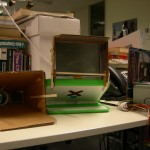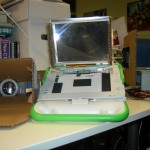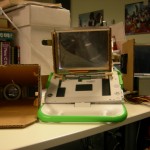Guest post by Yama Ploskonka
Yama wandered into the offices yesterday with some unusual gear.  We were all surprised that he managed to bring it onto the plane with him…
An LCD projector, the kind you buy at electronics stores for $500 or so is basically an LCD screen, a light source, and some optics, and stuff to keep it cool, build an image and such. The hard part of finding information in the internet about how to build one at home is that there is so much of it.
Mary Lou Jepsen has talked about building a $100 projector in the past, using different parts. But the XO happens to have an LCD screen, and differently from the screens I have hacked in before, the XO is designed to be easy to take apart.
Doing the basic set up took me about 6 months of imagining, and 6 hours of actual work – your mileage may vary.
The end result was exciting, we actually were able to see the XO screen projected on the wall. Details and procedure below the fold.
Materials and procedure
An XO, a projector lens (mine is probably over 50 years old, the stuff any Wall-e garage has. Similar ones on eBay go for about $20), a condenser (in this case a plastic Fresnel lens, page-size, split in half), a 7″x 5″ piece of clear glass, a couple ex-PC fans, an AT power source, a strong light source (again, a 50 year old item I had around, 750 W), aluminum foil, a strong cardboard box, formerly carrying Clorox jugs, hot glue.
The first challenge was finding out if the XO screen would work. For this, I dissasembled the screen, an easier task than any LCD I have messed with. That it might not work had to do with the XO screen being a new and amazing technology in itself, I assumed there might be something that would complicate things. Nope, the screen, once you have removed the backlight unit, is reasonably traslucent, just as other LCDs I have turned into projectors, and has a crisp sharp picture with any light behind it – I used a standard halogen bedside lamp for these tests.
Next challenge was figuring out the right focal length for the assembly. For this I did now use the XO screen, to avoid damage, but a dummy transparency sandwiched between the Fresnel pieces. Turned out that about a foot was right, both for the light source and the projector lens.
Then the assembly itself. I will not go into details, it was full of trial-and error to figure out something that 1) worked 2) could be dissassembled for packing to bring it to Cambridge. The AT power source was merely to provide 12 volts for the fans, and probably could also do it for the XO. The fans are to keep the contraption as cool as possible. The glass should be between the light source and the condenser/screen assemblage so that as little heat as possible gets to the screen – 750 w is a decent rating for a room heater!
Once the front assembly proved good, including a sort of rails setup to be able to move the lens closer or father away from the screen to focus, I traded the transparency for the XO screen, attached it to the XO itself, powered up.
When testing at home I had used that halogen lamp. I got an image, but it was faint and the room needed to be completely dark. Then I packed up (1:35 before my flight time), came to 1CC, and when I was able to, I started the assembly for the 750 w monster. That should probably project me a 12 foot image in a normal classroom, I expected. Lots of precautions so the thing would dissipate heat and not get me to be remeembered in history at the guy that burned down the OLPC headquarters.
Problem: even with fans and aluminum foil dissipators it gets HOT! at some moment I started seeing the image develop a hole in the center. Bad! My Fresnel melted? The XO screen messed up ($80 to replace)? No! Hats off to Mary Lou Jepsen and her team that developed the XO screen. That thing is /resilient/! A few minutes after allowed to cool, the screen was back to normal and maybe not the worse off for wear.
Bottom line
an XO projector is possible. A cooler source of light, maybe a LED array might be a better option, for several reasons. This would simplify assembly, operation and cost for there would be no need for extra fans, extra power source, all the heat precautions. Then, 750 W is beyond what developing nations school power installations can handle, it probably would fry the wiring in their walls, so such a setup would not be consistent with a lot of what we stand for, have no reproducibility.
Why even try?
In the classroom the teacher provides information that the students learn from. This model has been in force for a goodly few thousand years, and it is still the standard procedure at all levels of education. Reformers might add some twists; textbooks, research in reference materials, the internet, yet a teacher presenting is the way things are done.
We pursue the 1-to-1 model as a revolution where the child assumes a lot of the decision on what he wants to learn from. This model has its limtations, howvever; it empowers, but leaves behind a lot of the structure that is the core of the way education and learning is understood worldwide. Often the XO laptops are used by teachers as an extension of their traditional model, that is, they assign a webpage or activity to all the children at the same time, and explain from it, using the personal screens as a sort of multimedia individual blackboard the teacher still is in control of.
Something that allows the teacher to present to the whole class has been requested and sought after as OLPC became a reality. It was thought at some moment that the mesh would allow that, but it doesn’t. While this would be somewhat against the central 1-on-1 philosophy, it’s not the humoring of present structures we need to pay attention to. If the hallowed halls of the Ivy league and every high-level University still use it, the 1-to-many paradigm centered on the teacher must have something good to it.
Furthermore, it has beein pointed at that even with all our efforts, 1-to-1 is expensive. A 1-to-many that actually improves the present and maybe opens the way for the future deserves some attention.
Enter the projector. Now, for a conventional ‘datashow’ projector you also need a computer. Together they run you into at least a thousand dollars, if you are going for the least expensive set possible.
This is too expensive, and not really an alternative for developing countries. Something that valuable tends to get stolen, and replacing a bulb or another part is often impossible also.
Wouldn’t it be great that we could use the same approach to technology that made the XO a trailblazer, combining prize cutting design, ruggedness, and education-specific design that discourages misuse?
Actually, it’s almost done already. Just needs a few tweaks. The XO Projector can be made real, and could add some, maybe just a little of the actual potential of Sugar to flavor 1-to-many education. With suitable content, it could possitively impact and empower teachers, give kids a better chance than what they are getting and already gain, through the use of Sugar, a foothold for further work, at a minimal fraction of the cost.




For theatrical lighting the heat issues are taken care of by using reflectors which are *transparent* to infrared. IE, all the head dissipates in all directions, and only the non-heat light gets focused through the lens/screen assembly. The ETC Source-4 (http://www.etcconnect.com/minisite/sourcefour/index.html) was the first theatrical fixture to do this, and if you click on the link there’s a nice little animated graphic showing roughly how it works. Using a Source-4 or other theatrical fixture as your base light source — or just the reflector from one — should help a lot with heat management.
Interesting. It seems that the main problems are the heat produced by the bulb and the amount of electricity required to power it…. plus you need to disassemble an XO and build it.
Could the reflective properties of the screen be combined with a LED (low heat) light source. That way you could have a fold out hood/box which could be placed over the XO’s screen to project onto a larger screen – think about the large Samsung DPL TV’s.
Cheers,
Mungewell.
Want to see it running, have a picture?
You should enable OpenID on this site as well 🙂
You are totally correct! The funny thing is that as a final check I had located several errors, and then transfered the file from my XO (yes, I eat my own catfood, an XO is my work machine), but the version I transfered to a USB flash ended being the one a couple minutes before the last. I guess that to make sure Sugar is saving needs an extra Ctrl-S right before transfer. Will try to remember next time. Thank you!
This is so cool.
Correction: “For this I did now use the XO screen” believe the word intended is “not” (yes, I do hang around Groklaw)